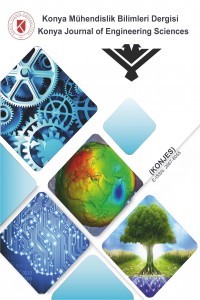İdeal Atkinson Çevriminin Özgül Net İş ve Ortalama Efektif Basınç Temelli Termodinamik Analizi ve Optimizasyonu
Atkinson Çevrimi, Optimum Sıkıştırma Oranı, Ortalama Efektif Basınç, Özgül Net Iş, Atkinson Cycle, Optimal Compression Ratio, Mean Effective Pressure, Specific Net Work
SPECIFIC NET WORK AND MEAN EFFECTIVE PRESSURE BASED THERMODYNAMIC ANALYSIS AND OPTIMIZATION OF IDEAL ATKINSON CYCLE
___
- Balmer, R. T, 2011, Modern engineering thermodynamics-textbook with tables booklet. Academic Press.
- Boggs, D. L., Hubert, H. S., & Schechter, M. M., 1995, The Otto-Atkinson cycle engine-fuel economy and emissions results and hardware design. SAE transactions, 220-232.
- Borgnakke, C., & Sonntag, R. E., 2020,. Fundamentals of thermodynamics. John Wiley & Sons.
- Cengel, Y. A., Boles, M. A., & Kanoğlu, M., 2011, Thermodynamics: an engineering approach. New York: McGraw-hill.
- Costea, M., Petrescu, S., Feidt, M., Dobre, C., & Borcila, B. (2021). Optimization modeling of irreversible Carnot engine from the perspective of combining finite speed and finite time analysis. Entropy, 23(5), 504.
- Ferguson, C. R., & Kirkpatrick, A. T., 2015, Internal combustion engines: applied thermosciences. John Wiley & Sons.
- Ganesan, V., 2018, Thermodynamics: basic and applied. McGraw-Hill Education.
- Gonca, G., & Sahin, B. (2022). Performance investigation and evaluation of an engine operating on a modified dual cycle. International Journal of Energy Research, 46(3), 2454-2466.
- Grohe, H., 2003, Otto-und Dieselmotoren, 13. Auflage, Vogel Fachbuch.
- Halderman, J. D., & Mitchell, C. D., 2014, Automotive technology. Pearson.
- Kim, S., Baik, Y. J., & Kim, M. (2022). Thermodynamic analysis of general heat engine cycle with finite heat capacity rates for power maximization. Case Studies in Thermal Engineering, 35, 102067.
- Moran, M. J., Shapiro, H. N., Boettner, D. D., & Bailey, M. B., 2010, Fundamentals of engineering thermodynamics. John Wiley & Sons.
- Nag, P. K., 2013, Engineering thermodynamics. Tata McGraw-Hill Education.
- Palaci, Y., & Gonca, G., 2020, The effects of different engine material properties on the performance of a diesel engine at maximum combustion temperatures. Thermal Science, 24(1 Part A), 183-191.
- Pauken, M., 2011, Thermodynamics for dummies. John Wiley & Sons.
- Potter, M. C., & Somerton, C. W., 2014, Schaum's outline of thermodynamics for engineers. McGraw-Hill Education.
- Rajput, R. K., 2009, Applied thermodynamics. Laxmi Publications, Ltd.
- Rajput, R. K., 2009, Engineering thermodynamics: A computer approach (si units version). Jones & Bartlett Publishers.
- Şahin, H., & Gonca, G. (2021). Endoreversible Performance Analysis of a modified dual cycle and comparison with the classical engine cycles. Avrupa Bilim ve Teknoloji Dergisi, (27), 1003-1009.
- Schmidt, A., 2019, Technical thermodynamics for engineers. Springer Nature: Cham, Suisse.
- Wang, R., Ge, Y., Chen, L., Feng, H., & Wu, Z. (2021). Power and thermal efficiency optimization of an irreversible steady-flow lenoir cycle. Entropy, 23(4), 425.
- Whitman, A. M., 2020, Thermodynamics: Basic Principles and Engineering Applications. Springer.
- Wu, C., 2007, Thermodynamics and heat powered cycles: a cognitive engineering approach. Nova Publishers.
- Zhao, J., Xu, M., Li, M., Wang, B., & Liu, S., 2012, Design and optimization of an Atkinson cycle engine with the Artificial Neural Network Method. Applied energy, 92, 492-502.
- Yayın Aralığı: Yılda 4 Sayı
- Başlangıç: 2004
- Yayıncı: Konya Teknik Üniversitesi
TEPEKENT (KONYA-ORTA ANADOLU) YÖRESİNDEKİ VOLKANİK KAYALARIN PETROGRAFİSİ, JEOKİMYASI VE PETROLOJİSİ
Büşra ERYİĞİT, Huseyin KURT, Kürşad ASAN, Gülin GENÇOĞLU KORKMAZ
Ni-FeNi3-Fe3O4 METALİK NANOALAŞIMLARIN HİDROTERMAL YÖNTEMLE SENTEZİ VE KARAKTERİZASYONU
Mehmet Şahin ATAŞ, Özlem ALTINTAŞ YILDIRIM
SERAMİK MALZEMELERİN İŞLENMESİNDE UYGULANAN ALIŞILMAMIŞ İMALAT YÖNTEMLERİ
İsmail Aykut KARAMANLI, Mustafa GÜNAY
TRANSFORMATÖR-TABANLI EVRİŞİMLİ SİNİR AĞI MODELİ KULLANARAK TWITTER VERİSİNDE SALDIRGANLIK TESPİTİ
Trimble-RTX’in Farklı Uydu Kombinasyonlarında Nokta Konumlama Performansı
Burhaneddin BİLGEN, Cevat İNAL, Sercan BÜLBÜL
ATMOSFERİK PARTİKÜL MADDELERİN MAKİNE ÖĞRENMESİ İLE TAHMİNİ: BEŞİKTAŞ, İSTANBUL ÖRNEĞİ
KENTSEL DÖNÜŞÜM PLANLAMAVE UYGULAMA STRATEJİLERİNDE 5393 VE 6306 SAYILI KANUNLARIN KARŞILAŞTIRILMASI
Sıtkı Alper ÖZDEMİR, Mustafa Tolga ÇÖĞÜRCÜ, Mehmet Akif ARSLAN, Mehmet UZUN
PPP VE RADYOSONDA’DAN ELDE EDİLEN YOĞUŞABİLİR SU BUHARI (PWV) DEĞERLERİNİN KARŞILAŞTIRILMASI
